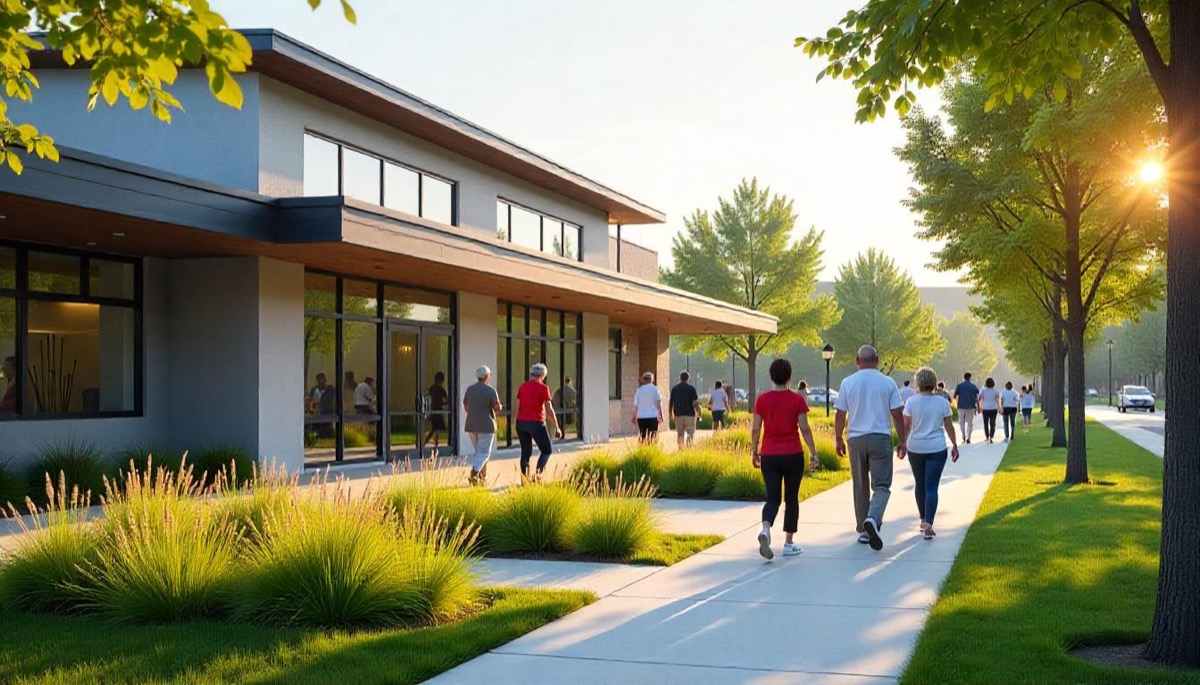Reno is gearing up to redefine the experience at Teglia’s Paradise Park with ambitious plans for enhancing its facilities and infrastructure. Nestled just adjacent to Sparks’ border yet firmly within Reno’s limits, the park has long been a vital recreational hub for the community. With a mixed demographic drawing visitors from seniors to families, the city’s latest blueprint aims to revamp the activity center and upgrade the park’s sprawling outdoor amenities. Community input is a cornerstone of this redevelopment, with workshops designed to incorporate resident feedback into the master plan.
Strategic improvements to Paradise Park’s activity center to enhance recreation services
The heart of the proposed enhancements lies in Paradise Park’s activity center, a facility frequently utilized by the city’s senior population. With a focus on accessibility, comfort, and versatility, the city of Reno has identified this hub as a critical component requiring modernization to meet evolving community needs. The activity center not only provides a meeting space but also serves as a focal point for a host of recreational programs and services.
Karina Mercier, Reno’s park planner, indicates that the city is crafting a guiding document—a master plan—that will steer these developments. This plan prioritizes improving the interior spaces, updating fitness and wellness equipment, and integrating technology to accommodate hybrid event hosting. As part of this initiative, adaptive design features will ensure that individuals with mobility challenges can fully enjoy the renewed facilities.
Beyond physical improvements, there is an emphasis on expanding program offerings tailored to seniors, such as low-impact fitness classes, social clubs, and educational workshops. From monthly art sessions to nutrition seminars, the goal is to create a vibrant, inclusive community hub that fosters connection and wellbeing among older adults.
Features slated for renovation and addition in the activity center include:
- Enhanced accessibility through ramp upgrades, widened doorways, and ergonomic furnishings.
- Modernized fitness equipment designed for variable abilities, including seated cardio machines and low-impact strength trainers.
- Digital infrastructure improvements such as high-speed Wi-Fi, smart audiovisual systems, and virtual meeting capabilities.
- Dedicated multipurpose rooms for hobby groups, counseling services, and wellness programs.
- Improved climate control systems to ensure year-round comfort during indoor activities.
These enhancements promise not only physical upgrades but also a qualitative leap in service provision for community members frequenting the activity center. The city hopes the renewed space will function as a beacon of social and recreational vitality for seniors and the general public alike.
| Planned enhancements | Expected benefit | Target user groups |
|---|---|---|
| Accessibility upgrades (ramps, doorways) | Improved mobility and safety | Seniors, users with disabilities |
| Fitness equipment revamp | Increased participation in wellness activities | All age groups, especially seniors |
| Digital infrastructure | Remote access to programs and meetings | Community members preferring virtual engagement |
| Multipurpose rooms | Wider program variety, more flexible use | Community clubs, workshops, counseling |
| Climate control improvements | Comfort throughout seasonal changes | Indoor facility users |
Such forward-thinking renovations will expand the park’s outreach and adapt to shifting social trends toward holistic community recreation. The upgrades align closely with Reno’s commitment to providing excellent, accessible municipal services.
Upgrading outdoor infrastructure: revitalizing walking paths and park amenities
Paradise Park’s outdoor features hold a special place in the community’s heart, particularly the walking paths that form the backbone of daily recreational activity. Recognizing this, the city’s master plan emphasizes substantial improvements to the park’s infrastructure to make outdoor engagement safer, more inviting, and ecologically sustainable.
Currently, the walking paths offer scenic routes alongside the stormwater retention basin, attracting regular visitors who prioritize fitness and nature appreciation. However, outdated trail conditions and limited lighting have prompted the city to consider comprehensive rehabilitation.
Proposed upgrades include resurfacing the trails with durable, permeable materials that support accessibility while promoting environmental stewardship. Enhanced route signage, accessible benches, and improved lighting will encourage extended use during early morning and twilight hours—peak times for walkers.
- New trail resurfacing using eco-friendly, ADA-compliant materials
- Installation of energy-efficient, solar-powered lighting for safety and reduced environmental impact
- Updated informational signage to highlight flora, fauna, and park history
- Additional rest areas with ergonomic seating designed for comfort and ease of use
- Landscape enhancements to accentuate natural beauty and support biodiversity
These outdoor infrastructure improvements do not merely add aesthetic value but actively contribute to public health by promoting regular physical activity and connecting residents with natural surroundings. The upgrades will also aim to accommodate emerging recreational trends such as bird watching, outdoor yoga, and family picnicking.
| Upgrade area | Details | Community benefits |
|---|---|---|
| Trail resurfacing | Permeable, ADA-compliant materials | Improved safety and year-round usability |
| Solar-powered lighting | Energy-efficient, environmentally friendly | Extended park accessibility during low light |
| Informational signage | Educational content about local environment | Enriched visitor experience and awareness |
| Seating areas | Ergonomically designed benches | Comfort for all visitors, including seniors |
| Landscape improvements | Native plants and biodiversity focus | Ecological enhancement and park beauty |
By marrying technology with nature, these outdoor enhancements represent Reno’s strategic investment to evolve Paradise Park into a model of sustainable urban recreation. Such projects enrich community life and acknowledge the critical link between environment, well-being, and quality infrastructure.
Balancing community needs: public involvement and feedback in shaping Paradise Park’s future
The ongoing planning process for Paradise Park sets a commendable example of public engagement in urban development. In March, Reno hosted a community workshop at the park’s activity center, inviting residents to voice their opinions and priorities concerning proposed upgrades. This democratic approach ensures that redevelopment respects the community’s diverse recreational preferences and cultural values.
Many attendees stressed the importance of preserving the park’s role as a serene retreat while advocating for improved amenities to support health and social activities. Seniors highlighted the need for comfortable, accessible environments where they can foster friendships and stay active. Families expressed interest in expanded playgrounds and picnic areas, reinforcing the park’s function as a family-friendly destination.
Following this interactive session, the city’s renovation roadmap now incorporates:
- Flexible programming spaces adaptable to various community-led events and classes.
- Prevention of overcrowding through thoughtful space design and scheduling.
- Enhanced connectivity between the activity center and outdoor amenities for seamless user experience.
- Priority on natural aesthetics preserving green spaces and mature trees.
- Continuous feedback mechanisms allowing ongoing citizen participation during and after development phases.
This model of civic collaboration showcases how municipal authorities can balance infrastructure ambition with grassroots input, ultimately delivering improvements genuinely attuned to community needs. It sustains trust and ensures that enhancements uplift rather than disrupt local identity.
| Community feedback themes | City response | Expected result |
|---|---|---|
| Preservation of natural spaces | Strict landscaping guidelines | Maintained park beauty and biodiversity |
| Accessible, senior-friendly design | Inclusive upgrades in facilities | Increased senior participation |
| Expanded family amenities | Addition of playgrounds and picnic zones | Broadened visitor demographics |
| Flexible community spaces | Multipurpose rooms and outdoor areas | Enhanced programming variety |
| Ongoing engagement | Regular public workshops and surveys | Adaptive development reflecting evolving needs |
Community involvement remains pivotal throughout the upcoming months as Reno finalizes the master plan, with stakeholders eager to see tangible progress by May when the Parks and Recreation Commission is set to review the finalized proposals.
Integrating sustainability and environmental stewardship in park facilities and recreation areas
Modern facility enhancement trends underscore the imperative of environmental responsibility. Reno’s Paradise Park plans are no exception, embedding sustainability firmly within the developmental blueprint. This dual focus of improving recreational amenities while conserving natural resources aligns with current urban ecological priorities.
Energy-efficient design principles guide the refurbishment of the activity center, featuring solar panels, optimized insulation, and rainwater harvesting systems. Moreover, the choice of construction materials favors recycled and locally sourced components to minimize the carbon footprint.
On the outdoor front, vegetation management prioritizes native species to promote biodiversity. Stormwater management will harness updated retention systems, further enhanced by landscaping that mitigates runoff and supports wildlife habitats.
- Solar energy installation powering lighting and activity center utilities.
- Rainwater harvesting for irrigation to reduce potable water dependency.
- Use of recycled and sustainable construction materials in all phases of renovation.
- Native plant landscaping to sustain local flora and fauna.
- Stormwater system upgrades to prevent erosion and promote groundwater recharge.
By weaving sustainability into every facet of the enhancements, Reno positions Paradise Park as a forward-looking public space where recreation and ecology coexist harmoniously. This approach not only preserves the park’s aesthetic charm but also advances long-term environmental resilience.
| Sustainability feature | Description | Environmental benefit |
|---|---|---|
| Solar energy systems | Panels installed on the activity center roof and lighting fixtures | Reduced fossil fuel reliance and energy costs |
| Rainwater harvesting | Water collected from roofs used for irrigation | Lower water consumption and conservation |
| Recycled construction materials | Use of post-consumer recycled wood and metals | Decreased waste and carbon footprint |
| Native landscaping | Planting of drought-resistant and local species | Habitat preservation and low maintenance |
| Stormwater management | Upgraded retention walls and natural filtration systems | Prevents erosion and promotes groundwater recharge |
This holistic integration of green technologies and ecological mindfulness reflects a civic commitment to stewardship and sustainability. It also sets a precedent for park developments across the region.
Future outlook: anticipated impact of Paradise Park enhancements on Reno’s community well-being
The forthcoming enhancements at Paradise Park are poised to revitalise not only the park’s physical spaces but also the social fabric of the Reno community. As the park becomes a more inviting and resourceful venue for outdoor recreation and communal activities, it is expected to yield multifaceted benefits.
Local residents can look forward to expanded health opportunities via improved walking trails and senior wellness programs, fostering healthier lifestyles. Furthermore, enhanced amenities will support increased programming diversity—from art classes to nature events—attracting a broader demographic from multi-generational family groups to individual outdoor enthusiasts.
Social cohesion is anticipated to strengthen as the activity center and park grounds encourage interactions among residents of all ages, contributing to a vibrant community spirit. Importantly, the emphasis on sustainability and accessibility exemplifies Reno’s forward-thinking urban planning efforts to build inclusive, environmentally sound public spaces.
- Enhanced physical health through improved walking paths and fitness facilities
- Inclusive social spaces encouraging interaction across age groups
- Increased community programming bridging recreation, education, and wellness
- Environmental education through interpretive signage and native landscaping
- Long-term sustainability embedding eco-friendly infrastructure
These integrated enhancements together promise a transformative impact on Paradise Park’s role as a cherished community asset. This vision positions Reno as a leader in crafting recreational spaces with deep respect for both people and planet.
| Benefit category | Specific impact | Long-term effect |
|---|---|---|
| Health and wellness | Boosted opportunities for exercise and social support | Improved public health outcomes |
| Social inclusion | Multigenerational engagement and community cohesiveness | Stronger neighborhood bonds |
| Recreational diversity | Expanded programs attracting various users | Higher park visitation and satisfaction |
| Environmental awareness | Education via signage and native plants | Greater ecological stewardship |
| Sustainability | Green infrastructure lowering ecological footprint | Long-term park viability |
Frequently asked questions about Paradise Park enhancements in Reno
- Q1: When will the enhancements to Paradise Park be completed?
The master plan is expected to be finalized by May 2025, with phased implementation to follow as funding and schedules permit. - Q2: How can community members contribute feedback?
Residents are encouraged to attend scheduled workshops, provide online input through city portals, and participate in public surveys throughout the planning process. - Q3: Will the activity center remain accessible during renovations?
Renovation schedules are designed to maintain partial access, minimizing disruption to ongoing senior and community programs. - Q4: Are sustainability measures increasing the project’s cost?
While initial investments in green technology may raise upfront costs, these are offset by long-term savings in energy and maintenance as well as environmental benefits. - Q5: What new recreational programs can residents expect?
Expanded wellness classes, educational workshops, family events, and technology-enabled virtual activities are planned to complement upgraded facilities.


